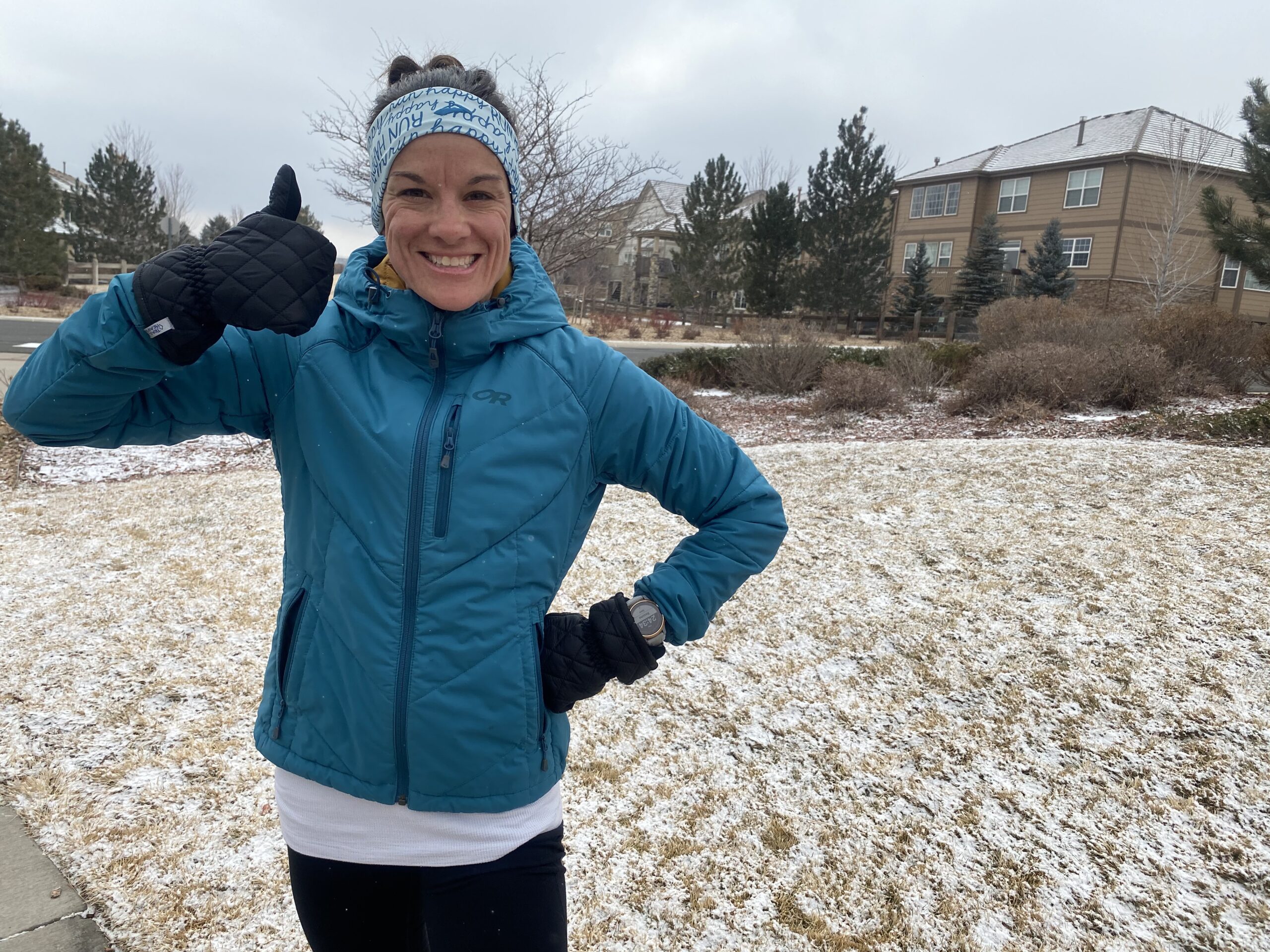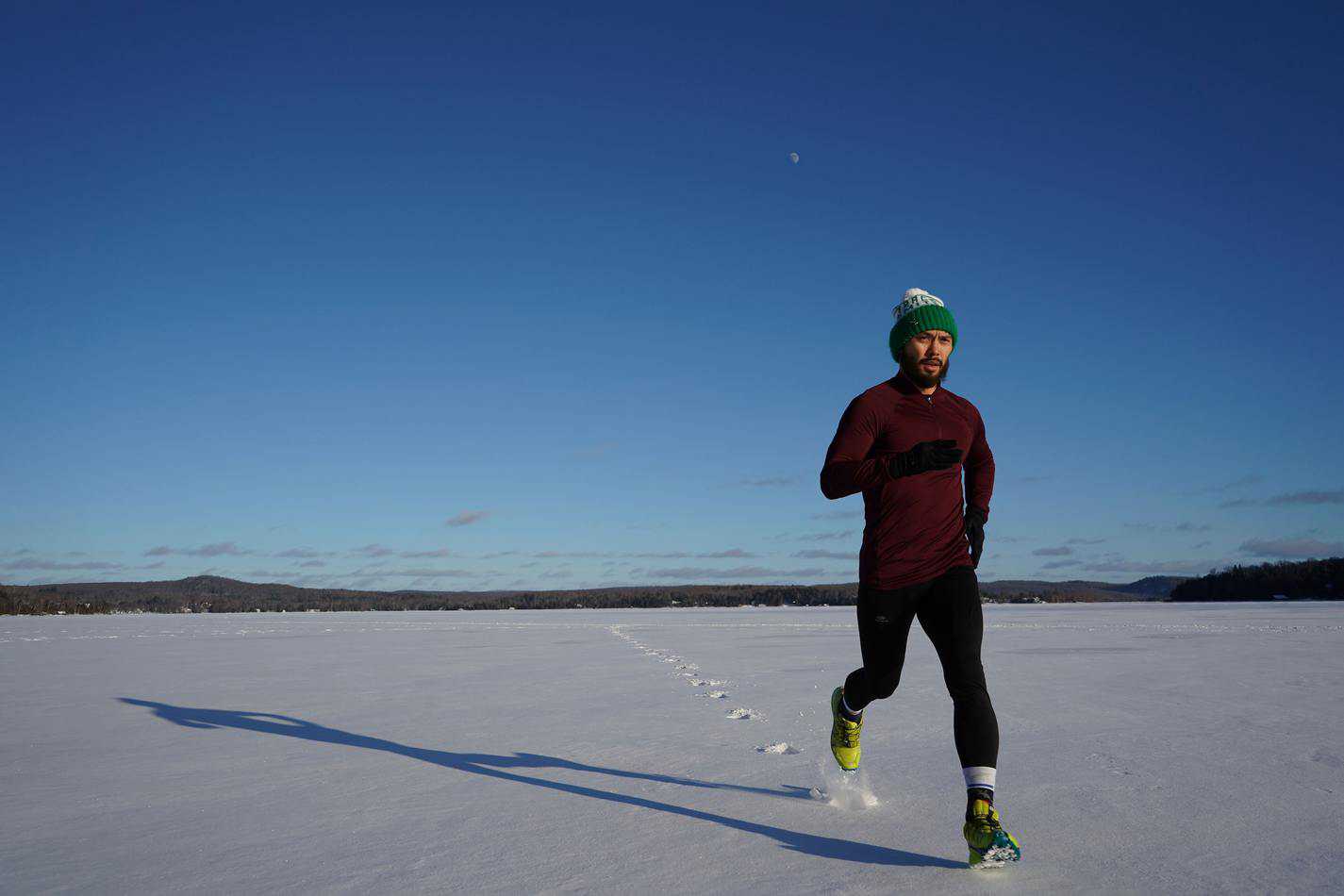Don’t skip your run or race just because the temperatures outside are frightful! Barring extreme conditions, you can and should keep running outside when it’s cold. Winter running builds mental toughness and aerobic endurance, among other benefits we discuss in this article.
We know heading out for a cold run can be daunting, so we put together this list of 10 of our top tips to help you stay consistent with your running all winter long.
Top 10 Cold Weather Running Tips
Running in the cold does not have to suck – we promise! It’s all about getting the routine and gear nailed down…once you have that, we think it’s pretty likely that you’ll like it quite a lot.
1. Complete Your Dynamic Warm-Up Indoors
And easy way to literally warm up your body AND minimize the amount of time you’re out in the cold is by completing your dynamic warm-up indoors, prior to heading out. Even if you’re driving to run somewhere, you can complete your warm-up at home prior to hopping in the car, so that you’re good to go once you arrive.
A warm-up is imperative, even more so when you’ll be out in the cold. It increases blood flow to the muscles and allows for increased mobility and flexibility. This will not only help you have a more comfortable run, but also reduces the risk of injury.
Need a good dynamic warm up routine? Check out Coach Jane’s 5 minute running warm up here!
2. Run Your First Mile on the Treadmill
Even with a warm-up the first mile of a cold-weather run can still feel pretty chilly!
A simple trick to avoid that discomfort: complete your first mile indoors on the treadmill, if you have one available to you. After your treadmill mile, you can head straight out the door to comfortably complete the rest of your run outside.
(And if you do decide to complete the entire run on your treadmill, that’s a-ok, too. It all counts toward your running mileage!)
3. Have An Accountability Partner or Group
When someone is counting on you to show up, it’s a lot easier to lace up and get out that door, no matter how cold it is outside.
Over the past couple of years, I have started running fairly regularly with a friend. The accountability of meeting her has been beneficial for getting my run in on cold or dreary days when I would otherwise put it off (or skip it altogether!) I’ve lost track of the amount of times we’ve met up in less-than-ideal weather and said to one another, “I’m so glad you’re here, I wouldn’t be doing this without you!”
Knowing that you’ll be letting your running friend(s) down by not showing up is immensely motivating. Plus, having company to chat with makes those miles fly by much faster than they do when you’re running alone. Having someone to run with makes running fun! You might even start looking forward to running in all kinds of weather, simply because of your running friend(s).
Don’t have a running friend or group yet? Ask your local running store if they sponsor or host a running group. Chances are, they do! You can also check your local social media pages for posts about running groups.
4. Know Your Local Clear Paths, Trails and Walkways
A reliably clear, dry road or path to run on is crucial to cold-weather running success.
Near where I live, there are certain trails that are almost always cleared of ice and snow after a winter storm. I’ve spent many winter runs on those trails, and while it can be boring to run the same stretches every week, it’s often the best place for me to get my outdoor run in without worrying about slipping and falling on ice (unlike running around my neighborhood, where roads can be iffy at times).
Some places have even better options: when I once visited Holland, Michigan, I learned that they have heated sidewalks throughout several downtown blocks. Their residents enjoy clear sidewalks year-round in that part of town. Running in circles around a downtown area might not have the most interesting views, but it would allow you to safely run free of snow and ice, and that’s what matters!
With cold weather, also comes short days with less light. This means there is a good chance you’ll be running in the dark either in the morning or evening. Running on a route that’s well-lit can help keep you safe, along with these other top tips.
5. Don’t Worry About Pace
It’s important to adjust pace expectations on a cold day since a colder environment can decrease muscle strength. Your pace is also likely to slow down if you’re trying to avoid stepping on ice and snow.
While you might worry about losing fitness when you slow down, the reality is that you’re actually benefitting your aerobic system and becoming a better runner when you truly run easy for the majority of your runs! In fact running 80% of your miles at an easy pace is one of the best ways to get faster, which is discussed in depth in this article.
Find yourself frustrated when you see a pace that’s “slow” to you?
A simple way to keep yourself from thinking about your pace is to adjust the screen on your GPS watch to only show your distance traveled. That way, you won’t be fretting about pace and how much you’ve slowed down compared to your warm weather paces.
So embrace that colder running knowing that not only do you not have to hold a quick pace, you’re actually likely benefitting your running more by taking the opportunity to slow down.
6. Bring Warm Water With You
You still need to carry water and stay hydrated during runs in the cold, even if it doesn’t seem as important as it does during the warmer months. One thing I’ve learned the hard way is that despite an insulated handheld water bottle, your water will start freezing and turning to ice if it’s really cold outside!
To avoid the frustration of frozen water, fill your bottle or hydration bladder with warm water before you set out. The water will cool down, but it’ll take longer to freeze, and you’ll still be able to hydrate as needed throughout your run.
7. Get the Right Gear to Stay Warm and Dry
Your cold weather gear (or lack of it) can be the difference between a bad run or a good run! We can’t emphasize this enough. Make sure that you’re dressing for both the temperature and conditions (such as wind, snow, rain, etc.) outside.
Here are some tips for getting your cold weather gear right:
Add 20 Degrees (Fahrenheit) to get your “feels Like” temperature:
We like to follow a guideline of adding 20 degrees F to the current temperature when it comes to choosing the right clothing for the elements. As you run, your core body temperature will rise, so utilizing this trick will help you avoid overdressing for your run which can be just as uncomfortable as underdressing.
For example, if it’s 25° F outside, you’ll want to dress like it’s actually 45°. However, if there is wind be sure to check the “feels like” temperature and add from there.
Layer your clothes:
Layers are crucial for comfort! By layering, you can easily shed clothing if you heat up, or add clothing back if conditions abruptly change for the worse. The following options should all be available in your closet and you can choose accordingly based on the elements:
- beanie or ear warmer
- neck gaiter
- long sleeve shirt
- vest, insulated coat or jacket (here are our top favorite waterproof jackets!)
- gloves or mittens
- moisture-wicking leggings (choose thermal for added warmth)
- warm socks (knee high will provide additional warmth – Smartwool ski socks are a great option!)
And if you are running in the early or late dark hours look for items of clothing that have reflective details to help keep you visible, too. For additional guidance, here is a handy visual guide from running podcaster Tina Muir, with examples of what to wear and how to layer depending on the weather situation.
Avoid cotton fabric clothing:
Cotton is one of the worst materials you can have next to your skin when you’re running in the cold (or ever honestly). It doesn’t dry quickly or wick away sweat; it becomes wet and clammy, causing chafing and an added chill to your body.
Instead, wear synthetic materials next to your skin, or Merino wool, which is both soft and moisture-wicking, and can help regulate your body temperature. Merino wool is especially great for socks and to use as a base layer.
Cover your hands and ears:
Your hands and ears need extra protection because your body reduces circulation to the extremities in order to send more blood to the vital organs when it’s cold. Make sure you are wearing gloves or mittens, and an ear-covering headband or hat. When it’s below freezing, I’ll even add hand warmers inside my gloves, to keep my fingers toasty!
Where waterproof running shoes:
If you are running in the cold, chances are good there will be times you’re also confronted with rain, snow or ice which is why having a pair of shoes specifically made for these types of conditions is a wise idea. Trail shoes typically provide the traction that you need to safely run on snow and ice (use your best judgment on this one) and if they are waterproof you can ensure your feet will also stay warm and dry. Check out our top favorites in our post Best Shoes for Running on Ice and Snow.
8. Protect the Exposed Skin on Your Face
The cold, windy, and dry air of winter can wreak havoc on skin, especially if it’s exposed for a prolonged period of time. Although most of your skin will already be covered by your gear, parts of your face are likely to be exposed to the elements on the run. Protect your face from chafing or chapping by smoothing on a thin layer of cream or ointment prior to heading out. We like products such as Aquaphor, Vaseline, and Eucerin, but any favorite cream or ointment should do the trick.
On the coldest and windiest of days a neck gaiter or balaclava can help protect you even more.
9. Alter Your Cool Down and Post-Run Recovery
Your body temperature can plummet quickly from the cold, and it’s easy to catch a chill in your sweaty gear toward the end of your runs. To avoid this, consider shortening your cool down and delaying your recovery to prioritize getting warmed-up first.
For example, if you typically jog a mile to cool down at the end of your runs, consider shortening it to half a mile so that you can get out of the cold more quickly.
Likewise, if you typically stretch or foam roll immediately after your run, consider taking a hot shower or sipping on a warm drink first when you come in from outside. You can do your stretching or foam rolling later, once your core temperature has gone up.
Have to drive home after a run? Change into a dry top if you can and crank that car heat!
10. Know When to Stay (or Go Back) Inside
Sometimes, despite all the best preparation, gear and knowledge, it’s just not a good day to run outside. And that’s okay! It can be tough to make the call to cut your run short or cancel it completely, but your safety and well-being is more important than whether you ran the mileage you were scheduled for that day.
How do runners know when it’s best to avoid a cold weather run?
Once in awhile choosing to run outside in the winter presents a risk. Severe windchills, poor visibility, black ice, unsafe roads, cold pouring rain, hail and blizzards are just a few situations where you should probably stay indoors or turn around as soon as possible. We share in this article further info to help you decide if it’s safe to run in the current cold conditions or not.
We hope that by following these tips, you can start enjoying running in cold weather!







